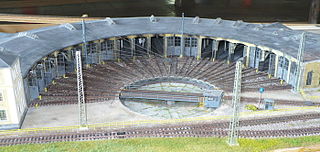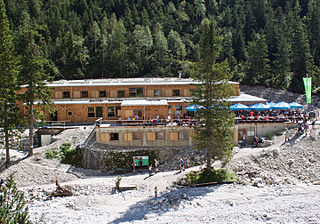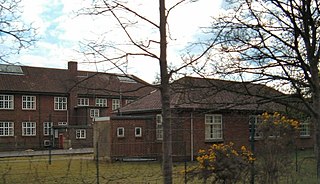
The Zugspitze, at 2,962 m (9,718 ft) above sea level, is the highest peak of the Wetterstein Mountains and the highest mountain in Germany. It lies south of the town of Garmisch-Partenkirchen in Bavaria, and the Austria–Germany border is on its western summit. South of the mountain is the Zugspitzplatt, a high karst plateau with numerous caves. On the flanks of the Zugspitze are two glaciers, the largest in Germany: the Northern Schneeferner with an area of 30.7 hectares and Höllentalferner with an area of 24.7 hectares. Shrinking of the Southern Schneeferner led to the loss of glacier status in 2022.

The Brig–Zermatt railway line is a metre gauge railway line in the canton of Valais in Switzerland. Its 44-kilometre-long (27 mi) line links the communities of Brig and Visp in the Rhone Valley with Täsch and the car free holiday resort of Zermatt in the Mattertal. The line also forms part of the much travelled and admired route of the Glacier Express between St. Moritz and Zermatt. The Gornergratbahn is connected with the line at Zermatt.

The Stuttgart Rack Railway is an electric rack railway in Stuttgart, Germany. It is the only urban rack railway in Germany, and one of only four rack railways operating in Germany, along with the Bavarian Zugspitze Railway, the Drachenfels Railway and the Wendelstein Railway.

The Seilbahn Zugspitze is an aerial tramway running from the Eibsee Lake to the top of Zugspitze in Bavaria, Germany. It currently holds the world record for the longest freespan in a cable car at 3,213 metres (10,541 ft) as well as the tallest lattice steel aerial tramway support tower in the world at 127 metres (417 ft). Construction of the system began in 2015 and it opened on 22 December 2017.

München Hauptbahnhof or Munich Central Station is the main railway station in the city of Munich, Germany. It is one of the three stations with long-distance services in Munich, the others being Munich East station and Munich-Pasing station (München-Pasing). München Hauptbahnhof sees about 450,000 passengers a day, which puts it on par with other large stations in Germany, such as Hamburg Hauptbahnhof and Frankfurt (Main) Hauptbahnhof. It is classified by Deutsche Bahn as a category 1 station, one of 21 in Germany and two in Munich, the other being München Ost. The mainline station is a terminal station with 32 platforms. The subterranean S-Bahn with 2 platforms and U-Bahn stations with 6 platforms are through stations.

Ulm Hauptbahnhof is the main station in the city of Ulm, which lies on the Danube, on the border of the German states of Baden-Württemberg and Bavaria in the Danube-Iller region.

Ingolstadt Hauptbahnhof is a railway station in the Bavarian city of Ingolstadt, situated in southern Germany. Ingolstadt station is an important junction in the Deutsche Bahn network. It has 7 platform tracks and is classified by Deutsche Bahn as a category 2 station.

Bavarian branch lines comprised nearly half the total railway network in Bavaria, a state in the southeastern Germany that was a kingdom in the days of the German Empire. The construction era for branch lines lasted from 1872, when the first route, from Siegelsdorf to Langenzenn, was opened, to 1930, when the last section of the branch from Gößweinstein to Behringersmühle went operational.

The Freilassing Locomotive World is a railway museum in the Berchtesgadener Land, which is operated with the cooperation of the town of Freilassing and the Deutsches Museum. The museum is located on the site of the former Freilassing locomotive shed which belongs to the Deutsche Bahn AG and houses part of the Deutsches Museum's railway collection. The second part of the collection is in the transport centre of the Deutsches Museum on the Theresienhöhe in Munich.

The Wetterstein mountains, colloquially called Wetterstein, is a mountain group in the Northern Limestone Alps within the Eastern Alps. It is a comparatively compact range located between Garmisch-Partenkirchen, Mittenwald, Seefeld in Tirol and Ehrwald along the border between Germany (Bavaria) and Austria (Tyrol). Zugspitze, the highest peak is at the same time the highest mountain in Germany.

At 971 m above sea level (NN) the Wurmberg is the second highest mountain in the Harz and the highest in Lower Saxony (Germany).

Wendelstein is a 1,838-metre-high (6,030 ft) mountain in the Bavarian Alps in South Germany. It is part of the Mangfall Mountains, the eastern part of the Bavarian Pre-Alps, and is the highest peak in the Wendelstein massif. It lies between the valleys of the Leitzach and Inn and is accessible via the Wendelstein Cable Car and the Wendelstein Rack Railway. On its northern foothills rises the Jenbach, which becomes the Kalten on its way to the River Mangfall. Local valley settlements include Bayrischzell, Brannenburg and Osterhofen.

The Schneeferner in the Bavarian Alps is Germany's highest and largest glacier.

The Bavarian Zugspitze Railway is one of four rack railways still working in Germany, along with the Wendelstein Railway, the Drachenfels Railway and the Stuttgart Rack Railway. The metre gauge line runs from Garmisch in the centre of Garmisch-Partenkirchen to the Zugspitzplatt, approximately 300 metres below Zugspitze, the highest mountain in Germany. The line culminates at 2,650 metres above sea level, which makes it the highest railway in Germany and the third highest in Europe. It is also the railway in Europe with the biggest height difference: 1,945 metres, the lower half being open-air and the upper half being underground.

The Wendelstein Rack Railway, sometimes just referred to as the Wendelstein Railway, is an electrically-driven metre gauge rack railway that runs up the Wendelstein in the Upper Bavarian Limestone Alps. Together with the Wendelstein Cable Car (Wendelstein-Seilbahn) it is operated by the Wendelsteinbahn GmbH. The mountain railway climbs through a total height of 1,217.27 metres. The Wendelstein Railway is one of only four working rack railways in Germany, the others being the Bavarian Zugspitze Railway, the Drachenfels Railway and the Stuttgart Rack Railway. It is also the second-highest railway in Germany, after the Zugspitze Railway, but the highest when considering only open-air railways.

The Zugspitze Glacier Cable Car is a 1,000 metre long cable car on the Zugspitze, Germany's highest mountain. It was opened in 1992 and links the plateau of the Zugspitzplatt directly with the summit, 360 metres higher. Since the mountain station of the Bavarian Zugspitze Railway was moved from the Schneefernerhaus to the Platt, the Schneefernerhaus and the old cableways, which ran down into the valley from the Platt and up to the summit (Gipfelseilbahn), have lost their importance.

The Reintalanger Hut (1,366 m) is an Alpine Club hut in the Wetterstein Mountains at the head of the Reintal valley. The River Partnach has its source in the vicinity. West of the hut the valley floor climbs steeply up to the plateau of the Zugspitzplatt below Germany's highest mountain.
Hammersbach is a village in the municipality of Grainau at the foot of the Wetterstein Mountains in South Germany. It is located at the southwestern end of the market town of Garmisch-Partenkirchen and is an important base for tours by mountaineers and hikers.

The Höllentalanger Hut is a managed hut owned by the German Alpine Club in the Wetterstein Mountains of Bavaria, in the district of Garmisch-Partenkirchen. The hut lies in a narrow defile between the Höllental-Blassen and Waxenstein-Riffelwand crest and is open from the end of May to mid-October. It has more than 80 bedspaces.

Bordon and Longmoor Military Camps are British Army training camps close to the A3 and A325 roads in and around the settlements of Bordon, Longmoor, Liss and Liphook in Hampshire, England. The main street of the Longmoor part of the camp is built on an ancient Roman road, the Chichester to Silchester Way, while the village of Greatham lies to the west. The combined camp and training area coveres 1,783 hectares of wooded areas, heath, wetlands and hard standings. Longmoor camp and the training areas are still active, and maintained by the Defence Infrastructure Organisation.



















